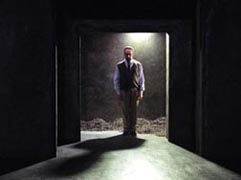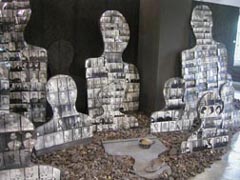
"Primo," a memoir of Auschwitz
by Italian resistance fighter, Primo Levi
Antony Sher gives chilling, moving account of the numbing minutae of evil
By Lucy Komisar
"Primo"
Adapted by and starring Antony Sher. Based on "If This is a Man" by
Primo Levi.
Directed by Richard Wilson.
Presented by the National Theatre of Great Britain.
The Music Box, 239 W. 45 St.
212-239-6200.
Opened July 11, 2005
Reviewed by Lucy Komisar July 22, 2005
Closes August 14, 2005
 |
| Anthony Sher in "Primo." Photo by Ivsn Kyncl. |
"Primo," Antony Sher's chilling adaptation and performance of the Italian Primo Levi's memoir of his year in Auschwitz, shows that the brutally mundane can sometimes be more horrific than the numbing statistics of victims. His details -- of being beaten with fists and sticks, of being constantly forced to strip and stand naked for hours, of watching comrades marched to their deaths, of scrounging for food -- make the numbers glisten with sweat and blood. The eeriest vision is his description of forced labor details shuffling off to sprightly German marching tunes.
Scher is a coolly matter-of-fact Primo, expressing rage quietly rather than shouting it. He depicts a careful, intellectual approach, almost scientific in its attention to detail. Levi was a young chemist of 24 when the Germans invaded Italy in 1943, and he became a partisan fighter. He was captured and sent to the Auschwitz concentration camp in Poland, but he was a survivor, and we see in the play how he learned quickly to use his wits. He discovered the uses of corruption, but also the importance of friendship and loyalty. He became buddies with another Italian chemist, and their food-sharing was a life-saver. A camp worker with access to food was generous to him, another life-saver. Primo found humanity in the midst of devilish evil. Perhaps, that saved his psyche as well as his body. The direction by Richard Wilson assures the dignity of the piece, eschewing melodrama.
 |
| Jozef Szajna, sandal among sculpture of photos. Photo by Lucy Komisar. |
I had visited Buchenwald, the concentration camp north of Weimar, Germany, just weeks before seeing the play, and the grim, gray stone walls and cells provided a vivid context for Primo's litany of humiliations and violence at the hands of SS officers. A stunning art exhibit on the top floor of the Buchenwald museum, the former camp storehouse, echoes some of Primo's lines. Transformed into a living production, The mottled grays walls of the set, set off only by a brown wood chair, reinforce the sense of overwhelming dreariness and death. In the play, Primo talks about how life often depended on the shoes one got. Prisoners' shoes were taken away, and they were given ill-fitting wooden-soled footware that brought sores to their feet and made them hobble. Death came quickly if one could not move fast enough for the overseers.
One of the works in the exhibit by Jozef Szajna shows a sandal carelessly thrown among some cutout silhouettes crafted from hundreds of victims' photos. Szajna's own life in the war years resembles Primo's. He was an opposition fighter of 19 when he was arrested by the Nazis and sent to Auschwitz and Buchenwald. Primo and Szajna lived, and so will their art.
![]()